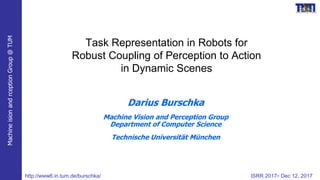Task-Representation for Robust Coupling of Perception to Action in Dynamic Environments
- 1. MachineisionandrceptionGroup@TUM http://www6.in.tum.de/burschka/ ISRR 2017- Dec 12, 2017 Task Representation in Robots for Robust Coupling of Perception to Action in Dynamic Scenes Darius Burschka Machine Vision and Perception Group Department of Computer Science Technische Universität München
- 2. MachineisionandrceptionGroup@TUM http://www6.in.tum.de/burschka/ ISRR 2017- Dec 12, 2017 We have seen Examples of the proposed Idea before... In static environments, two types of robot navigation evolved Map-based navigation Visual Servoing (Visual Maps)
- 3. MachineisionandrceptionGroup@TUM http://www6.in.tum.de/burschka/ ISRR 2017- Dec 12, 2017 Coupling Alternatives for Perception Modules M M Sensors Camera,IMU,Laser Structure-from-X Actuators 3D Map-based action planning Reactive behavior(Instincts) e.g., Obstacle avoidance,…
- 4. MachineisionandrceptionGroup@TUM http://www6.in.tum.de/burschka/ ISRR 2017- Dec 12, 2017 Task-Specific Indexing to Information Example – Collision Avoidance Cartesian maps originate from the time when the robot was the only moving agent in static environments - there, collision is proportional to distance to an object In dynamic environments, the collision avoidance task is a function of distance and velocity of the object = collision time
- 5. MachineisionandrceptionGroup@TUM http://www6.in.tum.de/burschka/ ISRR 2017- Dec 12, 2017 Capturing Motion Properties of Large Dynamic Scenes Derivation of the dynamic state for moving objects in large distances is not possible from consecutive metric reconstructions due to detection and calibration uncertainties.
- 6. MachineisionandrceptionGroup@TUM http://www6.in.tum.de/burschka/ ISRR 2017- Dec 12, 2017 Abstracting Information to 3D prohibits reliable Calculation of the Dynamic State
- 7. MachineisionandrceptionGroup@TUM http://www6.in.tum.de/burschka/ ISRR 2017- Dec 12, 2017 Direct Mapping of Point Motion on Image Observation Direction of motion and collision times can be observed directly from the properties of the projetion of imaged points in the images.
- 8. MachineisionandrceptionGroup@TUM http://www6.in.tum.de/burschka/ ISRR 2017- Dec 12, 2017 Fast Uncalibrated Monocular Segmentation of Independent Motion Components Analysis of the sparse optical flow in images can be used directly to group moving objects and define motion properties.
- 9. MachineisionandrceptionGroup@TUM http://www6.in.tum.de/burschka/ ISRR 2017- Dec 12, 2017 DariusBurschka–MVPGroupatTUM http://ww6.in.tum.de/burschka/ Dagstuhl Seminar Talk, Nov 9th, 2015 Optimisation in Collision Space (Schaub, Burschka ITSCC 2015)
- 10. MachineisionandrceptionGroup@TUM http://www6.in.tum.de/burschka/ ISRR 2017- Dec 12, 2017 Avoidance based on Collision Space from Uncalibrated Cameras
- 11. MachineisionandrceptionGroup@TUM http://www6.in.tum.de/burschka/ ISRR 2017- Dec 12, 2017 Conclusions  Cartesian Representation of the world is not always appropriate for task description  Exchange of information clos to the sensor representation results in more robust results – avoid external parameters  Parsing of actions can be defined as changes of contact relations in the world that can also be monitored directly in the image space.  Need of new research in • Optimization in new representations • Modification of the control approaches • Analysis of the task relevant physical properties (for sensor mapping)











